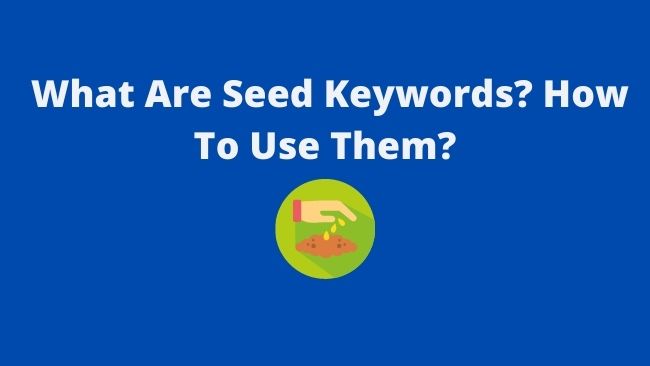Want to know what are seed keywords? What are the benefits and usage of a seed keyword? Don’t worry, stick to the end. You will get answers to all your questions.
A website’s success depends on the selection of keywords. All the search engine optimization efforts are useless if you don’t target the right keywords.
Thus, it’s important to choose the right keywords. The long-term success of your site depends on you selecting the right type of keyword. All the keywords come from a single keyword the seed keyword.
Here is the list of topics that we cover in this post:
Let’s start with the meaning of the seed keyword:
What Is A Seed Keyword?

A seed keyword is a short keyword containing one or two words. These short keywords have a very high monthly search volume and high competition. The short-tail keywords form a meaningful standalone word without any modifiers.
We use them as a seed for generating more keywords. After selecting the seed keyword. We combine it with other words and modifiers to come up with a long list of keywords.
The seed keyword forms the base of the site structure and site content. It’s from this seed the site structure and the site content sprout. The hub and spoke model of site planning starts with the seed keyword.
For example “content marketing” is a seed keyword. We can generate long-tail keywords by adding words and modifiers. Let’s say “content marketing strategy”, “best content marketing strategies” and many more.
What are the Benefits of Seed keywords for SEO?

The benefits of seed keywords for SEO are as below:
- Seed Keywords form the base of all your website activities. Starting with the seed keyword helps you focus your efforts around a specific topic. It improves the topical relevancy of your site. Thus, boosting the organic ranking of your website.
- It is easy to generate relevant long-tail keywords from a seed keyword. So, it keeps your SEO strategy on track.
- It helps you in coming up with your site’s main categories. You can pick words that form the category keywords.
- Seed keywords can help generate a lot of content ideas. The long-tail keywords target a specific topic or a problem. They form a good fit for blog post topics.
- When you write a blog post targeting a long-tail keyword. Your blog post will rank higher in the search engines. The search engines view your site as relevant to the topic. In the long run. The site starts ranking for short-tail keywords.
How to Choose the Right Seed Keywords?

Now you know the benefits of the seed keyword. Next, how to find seed keywords?
You should choose the right seed keywords that suit your site’s content. These seed keywords will generate long-tail keywords. And the long-tail keywords will shape your content.
The seed keyword like any short-tail keyword has very high competition. Don’t worry about the stiff competition. You are not targeting the seed keyword. You will target high volume low competition long-tail keywords. We will use the seed keywords to generate the long-tail keywords. Then, create content around these long-tail keywords.
If you already own a blog with content. It is easy for you to find out relevant high volume seed keywords. Find the ones that are driving the most traffic. Use them to find out related long-tail keywords and plan content around them.
If you are planning to start a blog/website. Or your site is in the early stages of development. Find out the right keywords related to your product or services. Then, create content around those keywords. The selection of a blog niche helps you in coming up with the right seed keywords.
For example. If you want to start a blog in the gardening niche. You can choose the seed keywords around gardening. The seed keywords can be “gardening ideas”, “gardening tools” etc.
How To Use Seed Keywords?

You should use the seed keyword on your site’s homepage. The homepage is the most important page. It gets links from most of the subpages. Optimise the subpages for the long-tail keywords we generate from the seed keywords.
Don’t optimise the homepage for a ton of keywords. For a good on-page SEO, use a maximum of three seed keywords on your homepage. The reason is the on-page SEO requirements.
For on-page SEO. We have to use the keywords in the title tags and meta description. The title tags support 60 characters and the meta description has a character limit of 160. We will not be able to include too many seed keywords in the meta tags.
How to Generate Long-tail Keywords using Seed Keywords?

Once you choose the right seed keywords for your site. You have a lot of keyword tools at your disposal to generate long-tail keywords. Some of the free tools are:
Google Keyword Planner
You can use the Google keyword planner tool for generating long-tail keywords. If you have a Google account you are good to go. Otherwise, you have to sign up for a google account. Then, navigate to ads.google.com.
From the top menu bar. Click on the Tools & Settings > Planner > Keyword Planner. On the next page click on “Discover New Keywords” and enter your seed keywords. Google internal search data will throw a huge list of long-tail keywords. These keywords contain seed keywords. Use these long-tail keywords to optimize the subpages.
Answer The Public
Answer The Public is a free tool that helps in generating long-tail keywords. It’s the tool that captures the autocomplete data for the search engines like Google. It throws out data in the form of useful phrases and questions that people are asking online.
It can help you come up with a ton of long-tail keywords and content ideas. Navigate to answerthepublic.com. Enter your seed keyword in the search box and click the search button. It will generate a huge list of long-tail keywords.
LSIgraph
With LSIgraph you can create a huge list of semantically related keywords. It will help you discover the most profitable keywords related to the seed keyword. LSI stands for latent semantic indexing. LSI keywords are semantically linked to a target keyword/search query.
To use this tool. Go to LSIgraph.com and enter your keyword in the search box. It will spit out a huge list of long-tail keywords that are semantically linked to your seed keyword. It will also give you the volume, competition, trend, and CPC etc.
Google Search
A simple Google search can help you discover seed keywords for your site. When you start typing Google autosuggest shows a list of seed keywords.
Check out the related searches at the bottom of the Google search result page (SERP). It presents you with frequently searched keywords related to your search query.
The People Also Ask snippet presents you with a list of questions. You can scan these questions and pick the seed keywords that relate to your query.
Google Search Console
If you are blogging for a while and you have linked your site with Google search console (GSC). Log in to the Google search console. Under the Performance Report, you will see all the queries for which your site is ranking.
You can filter the seed keywords using the filters. There are filters like Impressions and Position. You can filter the keyword for positions 1-10. Then, sort by impressions to find your most profitable seed keywords.
More Free Keyword Research Tools
Here are some more free keyword research tools. You can experiment with them and choose the ones that work best for you.
Read: 7 Step Quick Keyword Research for Blog Posts
Conclusion
The seed keyword is 1-2 words that form a meaningful word. The seed keyword is the starting point of any online business. It helps you come up with site structure and content. Seed keywords have very high competition and high search volume.
Seed Keywords have many benefits. The most important ones include:
- They help in deciding the categories for your site.
- Seed keywords help generate content ideas for your site.
The seed keyword is highly competitive. Thus, you should consider targeting the long-tail keywords. As your site gains authority you will start ranking for the seed keywords too.
Once you choose the seed keywords for your site. Use various free and paid keyword tools to generate long-tail keywords. These keywords help you decide the site categories and content ideas.
If you are reading up to this point you must have enjoyed reading the article. So what are your views on the seed keywords? How are you planning to use them?
I would be happy to hear from you.



![Read more about the article The Ultimate Guide to Blog Comments For Beginners [2024]](https://startblogpro.com/wp-content/uploads/2021/06/blog-comments-ultimateguide-300x169.jpg)

Pingback: How To Learn SEO Free - Beginners Guide | StartBlogPro
Pingback: How To Start a Food Blog and Earn Too? | StartBlogPro
Pingback: How to Build a WordPress Website in 60 minutes? | StartBlogPro
Pingback: How to Start a Fashion Blog and Make Money? | StartBlogPro